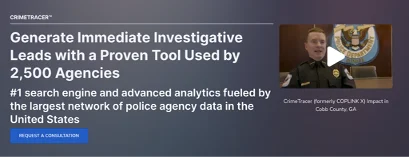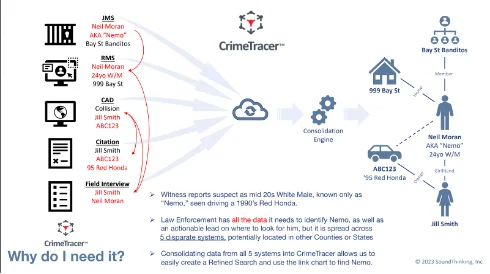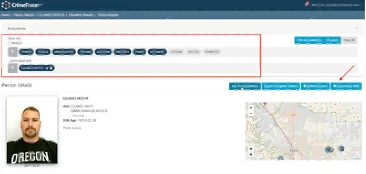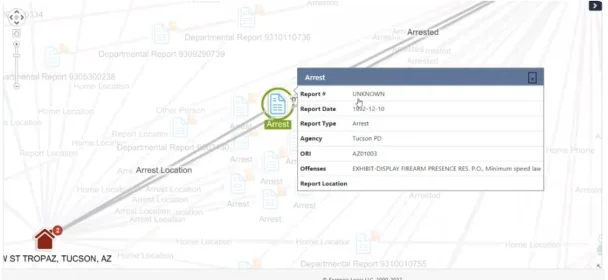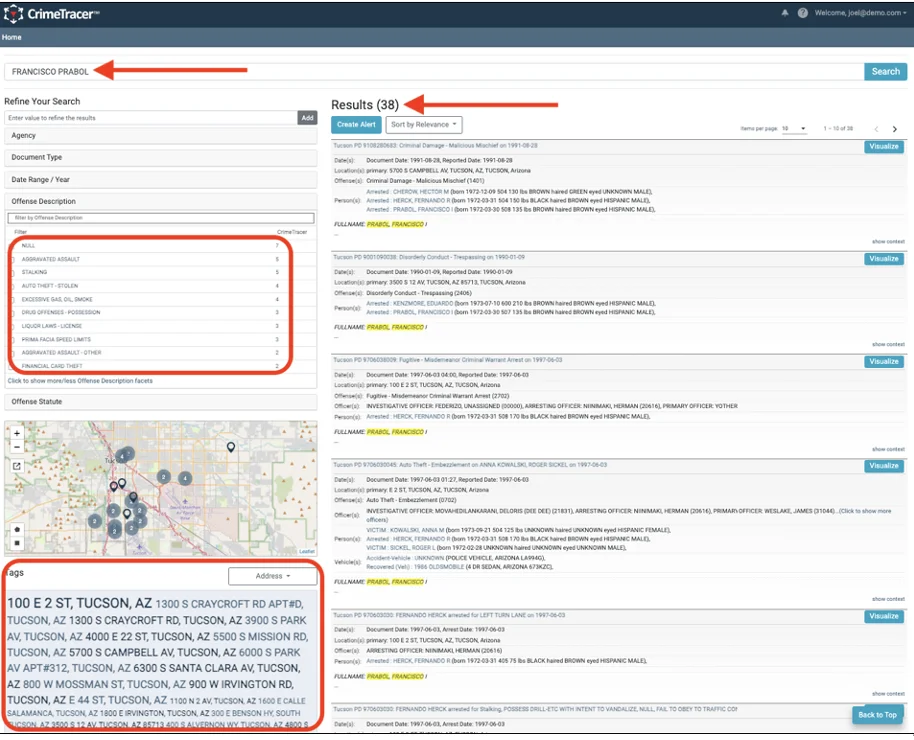Law enforcement agencies navigating staffing shortages often turn to law enforcement data management systems because of the following challenges:
- Data are often siloed, which means that investigators often must sift through multiple systems to find and make connections, a time-consuming and manual process. For investigative teams dealing with turnover or other staffing changes midway through a case, this can slow progress down even more.
- Patrol officers and investigative teams, bogged down with responding to a high level of crime, need force-multiplying technologies that can help them home in on leads and expedite the investigative process, but too many law enforcement data management systems are overly complex and counterintuitive.
- Interaction records often aren’t available because criminals can traverse jurisdictional boundaries, stalling progress on a case.
- Ineffective search terms result in lead pools that are unmanageably large.
- Because the lead pool is unmanageably large, it can be extremely difficult to research the connections between individuals and entities quickly and efficiently.
- Many agencies lack an efficient, scalable way to communicate (and receive) time-sensitive information that can help their investigative process.
In this post, we’ll provide an overview of SoundThinking’s law enforcement data management product, CrimeTracer, and how it can help your agency solve these challenges.
Looking to improve your agency’s data management and search engine capabilities? Reach out to our sales team to see if CrimeTracer makes sense for your agency.
An Introduction to CrimeTracer
CrimeTracer, formerly known as COPLINK X, is a powerful law enforcement search engine and information platform that enables investigators and command staff to search data from agencies across the U.S., using natural language speech terms and concepts.
The law enforcement data management category is broad. It includes information sharing systems like the National Data Exchange (N-DEx), data warehouses like the Law Enforcement Information Exchange (LInX), as well as Record Management Systems (RMS) from vendors like Motorola, Hexagon and Central Square.
CrimeTracer is the #1 law enforcement search engine and data management system that enables investigators to search through more than 1.3B structured and unstructured data records across jurisdictions to obtain immediate tactical leads, leverage advanced link analysis to make intelligent connections, link NIBIN leads to reports, suspects, and other entities, and so much more.
Key Feature # 1: Over 150+ Packaged Connectors to Biggest CAD/RMS Vendors
Out of the box, CrimeTracer comes with over 150 packaged connectors (APIs) to some of the most significant commercial CAD/RMS vendors, including but not limited to:
- Motorola
- Hexagon
- Central Square
- Versaterm
- Tyler
- Mark43
With these integrations, information is no longer siloed.
CrimeTracer consolidates the information from these and other vendors into one centralized dashboard that includes links to original data sources and specific reports in a certain city or state. With CrimeTracer, you can search and access more than 1.3 billion records, including 900 million agency records from more than 2,500 law enforcement agencies in 15 states. The records include police reports, CAD calls, arrests, bookings, crash reports, citations, and more.
In addition to agency records, CrimeTracer can access public records through the Thomson Reuters CLEAR platform. Investigators now have access to the information they need at their fingertips.
Key Feature # 2: Quick Search Feature to Obtain Immediate Tactical Leads
Given the fact that most investigative agencies are understaffed and overworked, they need a force-multiplying technology that makes their jobs easier, not harder.
CrimeTracer includes a “Quick Search” feature that allows investigators to obtain immediate tactical leads.
Quick Search finds information in both structured and unstructured data, and with it, patrol officers can access the records just like searching web pages on Google. A key difference in CrimeTracer is that a search can be initiated using natural language terms—other platforms require you to essentially fill out a search form.
For example, the video above shows a search query using a serial number from a gun confiscated during a suspect search, test fired, and run through ATF’s NIBIN ballistics matching system. The search query shows five results that include the original report, arrest, and case, as well as several pawn slips and a report of the gun being stolen.
CrimeTracer’s advanced search algorithm is designed to understand the different ways law enforcement information might be recorded. For example, the algorithm will automatically cross-reference 09/12/2023 to September 12, 2023, and it includes synonym dictionaries that will match “Honda sedan” to “Accord” or “Civic,” or “F150,” “Silverado,” and “Ram” to “pickup” or “truck.”
By leveraging our advanced law enforcement-centric search algorithms, officers can quickly find pertinent information to bolster officer safety, increase situational awareness, and solve more crimes in the field, reducing investigator caseload.
Key Feature # 3: Reporting Insights that Span Across Jurisdictional Boundaries
CrimeTracer aggregates and consolidates law enforcement data from multiple agencies and then from multiple data management systems within those agencies. This is particularly useful when an investigator is trying to make relevant connections to a suspect despite the suspect traveling through multiple jurisdictions.
For example, let’s say an investigator received a few witness reports and determined that the suspect they were looking for goes by the alias “Nemo.”
This may be one of the first crimes Nemo has committed in the investigator’s jurisdiction, and any records relating to those will be easily available.
But what if Nemo has a track record of crimes across several different states?
Normally, due to jurisdictional boundaries, investigators would not have access to key pieces of information from those other jurisdictions that could help clear the case. But CrimeTracer’s ability to aggregate and consolidate law enforcement data from multiple agencies, and from multiple data management systems within those agencies, is particularly useful when an investigator is trying to track a suspect traveling through several jurisdictions. CrimeTracer’s ability to consolidate information enables agencies to create a refined search, build patterns, and identify relationships between entities, regardless of jurisdictional boundaries.
Key Feature # 4: Hone Your Search with Sub-Categories
Most everyone has had the experience of doing a web search that produces overly broad results, followed by the tedious process of adjusting the search terms to focus the results. The same can be true with law enforcement data management systems—a simple word match on every search term won’t help narrow the field.
CrimeTracer can take information you receive from an investigation (witness, bystander, etc…) and search it against over 1.3 billion records to make a connection to someone with the same name. For example, Let’s say an investigator was conducting a case and the name ‘Keith Ellaney’ came up in the investigation as a suspect. The investigator could then take that name and search it in the CrimeTracer database.
Within the CrimeTracer search engine, you’re able to search by:
- License plate
- Address
- Firearm serial number
- Gang name
- Suspect description
- Crime types
- And many more
The ability to combine these search parameters means investigators can easily ask multidimensional questions. For example, if they’re investigating a robbery at a particular convenience store and have a partial witness description, they can look for any mid-40s white males that have associations to a black Nissan sedan and perhaps have a history of strongarm burglaries in the area around the convenience store. Or, if they have a suspect in custody and you want to find known associates by using specific indicators like identifiable markings, age, sex, or race, CrimeTracer can provide that information as well.
Key Feature #5: Ability to Review Connections Between Entities with Visualizer Toolbar
The most valuable part of refining searches in a law enforcement database is the ability to then build out a complete picture of a suspect’s activities, movements, associates, and so on. For example, who else lives at the same address as the suspect? What other incident reports might they have appeared in?
With CrimeTracer’s visualizer toolbar, investigators can easily visualize connections between entities by searching within charts, discovering how networks evolve over time, and applying social network analysis algorithms. For example, with CrimeTracer, investigators can look up an individual’s arrest records from across the country and the link chart displays potential connections linking each arrest.
CrimeTracer can map out the entirety of a suspect’s activity and “web of influence,” better helping investigators identify and understand how different pieces of a case all relate to each other.
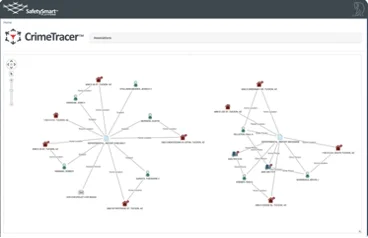
Example of a link analysis chart.
Key Feature #6:Crime Bulletins for Disseminating Time-Sensitive Information Across Jurisdictions
Criminals act fast and as we’ve discussed, frequently travel across jurisdictions, and commit more crimes as they go.
Because of these realities, it’s imperative that law enforcement moves just as fast to keep up.
CrimeTracer’s new Crime Bulletin feature allows authorized agencies to improve information sharing by uploading time-sensitive crime bulletins for immediate nationwide dissemination. Agencies can upload a PDF of a BOLO (Be On the Lookout), for example, and within minutes it will be searchable by anyone using the CrimeTracer application.
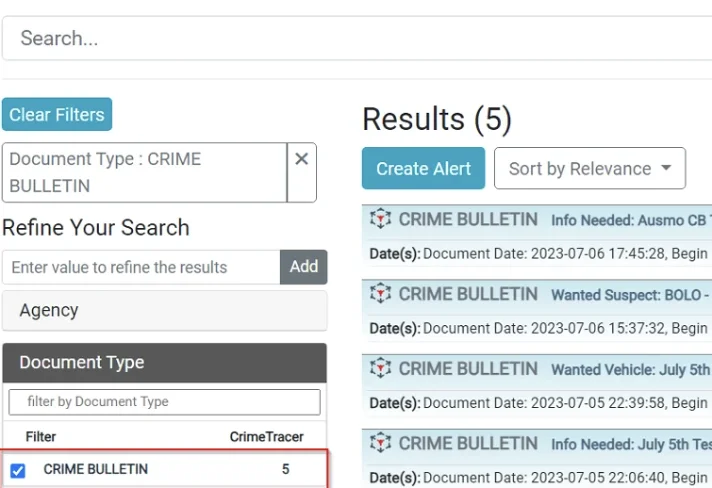
In addition to uploading your own Crime Bulletins, you can set an alert to be notified whenever another agency uploads a bulletin, filtering them by agency or other criteria. Accelerating the receipt and dissemination of key information is another way CrimeTracer makes the investigative process more efficient.
A Checklist for Assessing the Best Law Enforcement Data Management System
- Does the application come out-of-the-box with over 150 API integrations to leading CAD and RMS platforms?
- Does the application have a quick search feature to expedite the search process?
- Can the application consolidate law enforcement data from multiple agencies and from multiple data management systems within those agencies?
- Does application support sub-category search queries?
- Does the application support the ability to review connections with a visualizer toolbar?
- Does the application support easy uploads of Crime Bulletins?
Law Enforcement Data Management Systems: An Essential Tool for Modern-Day Policing
A law enforcement data management system is an essential tool in modern-day policing and crime prevention. The ability to find and correlate data makes investigations more efficient and effective. To learn more about how CrimeTracer’s law enforcement search engine and data management system can help your agency expedite the investigative process, contact us here.

